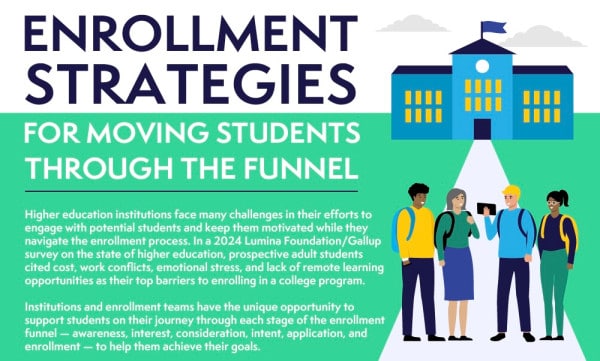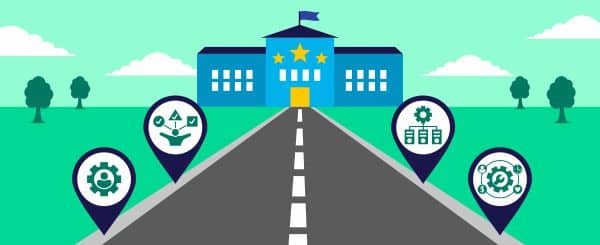5 Tips for Keeping Students Engaged Throughout the Admissions Process
In higher education, the enrollment funnel can feel like a battleground for institutions vying to convert interest into commitment.
Traditionally, the enrollment funnel has been viewed simply: attract, engage, and enroll. But the modern student’s journey is anything but straightforward — it’s a complex, winding path influenced by numerous digital touchpoints and personalized interactions.
The health of the enrollment funnel extends beyond mere numbers; it represents the institution’s ability to connect with prospective students through every phase of their decision-making process. With technology reshaping expectations and behaviors, colleges and universities must not only catch the eye of prospective students but also keep them engaged through multiple channels and strategies.
This article unpacks key elements of the enrollment and admissions funnel, offering actionable insights and innovative tips to capture and retain students’ attention from their first inquiry through their enrollment stages. As we explore these strategies, you’ll discover the vital role that continuous, tailored engagement plays in transforming interest into activity, setting the stage for a successful educational journey.
The Modern Student Journey
Today’s students embark on their educational journeys equipped with a wealth of information and digital tools at their fingertips, making their paths to enrollment more complex and multifaceted than ever before.
Complexities and Challenges
The student journey is far from linear. It involves numerous interactions across various platforms and touchpoints. Each student’s path is unique and influenced by personal, financial, and academic factors.
For instance, a modern student, such as a working professional returning to education or a parent seeking to balance family responsibilities with schooling, may have different priorities and use different resources compared to a younger, first-time college student.
Technology has diversified the ways students gather information, and also how they engage with institutions. Prospective students might start their journey by conducting a simple Google search, but they will also often visit social media platforms, participate in virtual campus tours, and attend online webinars before starting their application. During this time, they are continuously evaluating their options and being influenced by each interaction they have with a school’s digital presence.
Impact of Technology
The proliferation of digital platforms has dramatically altered the student journey, both for students and institutions, in ways such as the following:
- Digital Touchpoints: Websites, social media platforms, online forums, and virtual tours provide initial impressions and ongoing engagement. Prospective students can interact with current students and faculty, view online classes, and even participate in community events, all from their devices.
- Data-Driven Decisions: Students use data such as graduation rates, employment outcomes, and student and faculty testimonials to inform their choices. They expect personalized interactions and content that addresses their specific concerns and aspirations.
- Engagement Analytics: Institutions now have the tools to track and analyze how prospective students interact with their digital content. This data is invaluable for refining marketing strategies and improving engagement tactics to ensure they meet the expectations and needs of prospective students.
Given these technological influences, it is essential for educational institutions to adapt their enrollment strategies to meet the changing behaviors and preferences of modern students. Integrating data analytics, enhancing digital communication channels, and providing personalized experiences are all critical to effectively engaging with prospective students throughout their decision-making journey.
Understanding the Enrollment Funnel
The enrollment and admissions funnel is a foundational concept in higher education marketing that illustrates the progressive stages a student navigates, from awareness through enrollment. The funnel is not just a theoretical model but a practical guide for shaping effective engagement strategies.
6 Stages of the Enrollment Funnel
The enrollment funnel can be divided into several key stages, each requiring specific strategies to move prospective students to the next step:
- Awareness: This is the initial point where potential students first learn about an institution. Efforts here include broad-reaching advertising, social media presence, and participation in educational fairs. The goal is to cast a wide, though still strategic, net and garner interest from a diverse pool of students.
- Interest: Once awareness is achieved, the focus shifts to nurturing interest and familiarity. This involves providing more detailed information about what the institution offers, such as programs, support services for online students, and financial aid options. Content marketing, informational webinars, and targeted emails play a significant role in this stage.
- Consideration: At this juncture, prospective students are comparing their options. They might engage more deeply with admissions counselors, attend virtual or in-person campus tours, and participate in Q&A sessions. Personalized communication and reassurance about academic and social fit are crucial.
- Intent: The intent stage is where decision-making becomes serious. Prospective students might discuss their choices with family, friends, colleagues, or advisors, conduct comparative research, and seriously evaluate financial aid details and options. Institutions should focus on direct engagements, such as personal calls, text messages, or engagement-driven content, to solidify their interest.
- Application: The application stage is the formal step of submitting necessary documents and fulfilling admission requirements. Support through streamlined application processes, reminders, and help desks is vital to ease this phase for students.
- Enrollment: The final stage, where accepted students confirm their attendance and complete registration. At this point, effective communication about orientation, class selection, and enrollment procedures can ease the transition and ensure that students feel welcomed, supported, and valued.
A deep understanding and effective management of the enrollment and admissions funnel is crucial for any educational institution aiming to increase its student body. Let’s see how it’s done.
How to Keep Students’ Attention Through the Enrollment Funnel
Maintaining the attention of prospective students throughout their educational journey is crucial for successful enrollment. Here are key strategies to keep students engaged from initial inquiry through enrollment:
1. Consistent Engagement Across Channels
Leverage multiple channels to engage with students to ensure your institution remains top of mind. Implement a mix of digital and traditional marketing strategies to reach students where they are most active, such as the following:
- Digital Channels: Targeted social media ads, engaging video content, and informative blog posts
- Traditional Channels: Direct mail, phone calls, and face-to-face interactions during campus visits
2. Personalization and Differentiation
Tailor your communications to meet the specific needs and interests of each prospective student, and utilize data from their interactions with your digital content to personalize messages. Strategies to achieve these goals include the following:
- Segmented Email Campaigns: Customized emails based on the prospective student’s program of interest, engagement history, and stage in the funnel
- Custom Content: Relevant information that addresses specific concerns or questions that may arise at different stages of their journey
3. Incentives and Urgency
Create a sense of urgency and motivation by offering incentives that encourage prospective students to take the next step:
- Priority Deadlines: Upcoming application deadlines that can be highlighted to spur action
- Exclusive Offers: Application fee waivers or access to special events for early applicants
4. Building Relationships
Foster a sense of community and belonging from the first interaction through forums such as the following:
- Virtual Engagements: Live Q&A sessions with current students and faculty
- Personal Outreach: Admissions counselors who reach out personally to high-interest candidates
5. Continuous Improvement
Regularly assess and refine your engagement strategies based on feedback and analytics tools and processes:
- Feedback Loops: Surveys and feedback channels that gather insights from prospective students
- Analytics Review: Regular analysis of engagement metrics to adjust strategies and improve outcomes
It’s Time to Build Out Your Enrollment Funnel
The landscape of higher education is competitive, but the enrollment funnel could be your institution’s edge. By engaging prospective students at every stage of their journey with tailored strategies and personalized communications, institutions can significantly enhance their enrollment rates. If you’re ready to elevate your enrollment marketing strategies, Archer Education is here to take you to the next level. Reach out to us, and let us help you create a robust enrollment funnel that not only attracts but also converts prospective students into committed learners.



